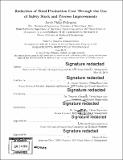Reduction of total production cost through the use of safety stock and process improvements
Author(s)
Pellegrini, Jacob Philip.
Download1119387335-MIT.pdf (7.222Mb)
Other Contributors
Sloan School of Management.
Massachusetts Institute of Technology. Department of Mechanical Engineering.
Leaders for Global Operations Program.
Advisor
Daniel Whitney, Timothy Gutowski, and Steven Spear.
Terms of use
Metadata
Show full item recordAbstract
In an ideal production system, supply exactly meets demand. Instantaneous, correct quantities arrive exactly at the right location when needed. However, real-world production systems often have variability- a change in the quantity demanded, a broken part, a shipping delay for a snow storm. The variability can be random, so companies are left with a dilemma: too little inventory buffer and a shortage may occur; too much inventory and capital is unnecessarily tied up in inventory sitting on the shelves. Using research conducted at the Boeing 737 program as a case study, this thesis proposes the application of a multi-step approach to optimize the total cost of the production system, balancing holding cost (inventory) with the disruption cost of a shortage. The initial pilot shows that small increases in inventory can have an order of magnitude of cost avoidance. The methodology includes system observation, qualitative interviews with Boeing employees, quantitative data gathering and analysis, proposed changes, and measured results. First, the historical supply and demand variability of the system is identified. Second, the cost of a shortage is estimated for the system. Next, an analytical approach to set safety stock levels is applied to balance the cost of inventory held with the cost of a shortage. By reducing the variability in the system, inventory levels can be reduced while maintaining the service levels. This process is then repeated at regular intervals to optimize the total cost of the system, balancing inventory holding cost and the disruption cost of a shortage.
Description
Thesis: M.B.A., Massachusetts Institute of Technology, Sloan School of Management, 2019, In conjunction with the Leaders for Global Operations Program at MIT Thesis: S.M., Massachusetts Institute of Technology, Department of Mechanical Engineering, 2019, In conjunction with the Leaders for Global Operations Program at MIT Cataloged from PDF version of thesis. Includes bibliographical references (pages 76-77).
Date issued
20192019
Department
Sloan School of Management; Massachusetts Institute of Technology. Department of Mechanical Engineering; Leaders for Global Operations ProgramPublisher
Massachusetts Institute of Technology
Keywords
Sloan School of Management., Mechanical Engineering., Leaders for Global Operations Program.